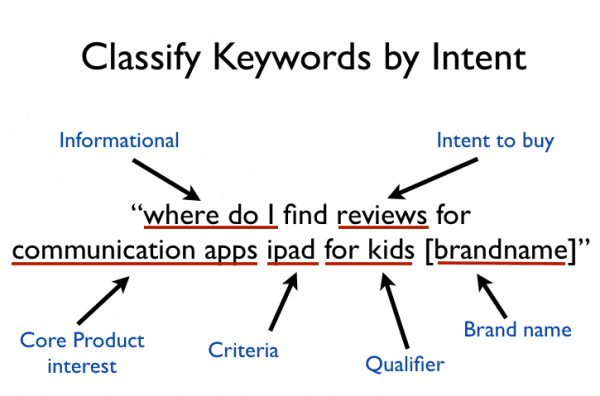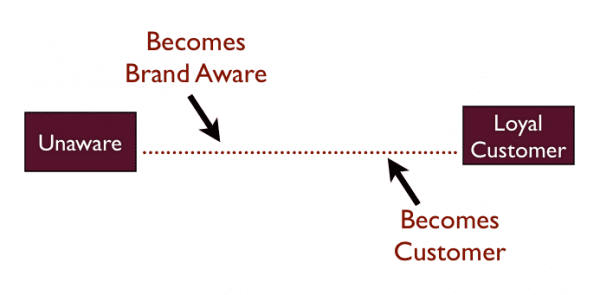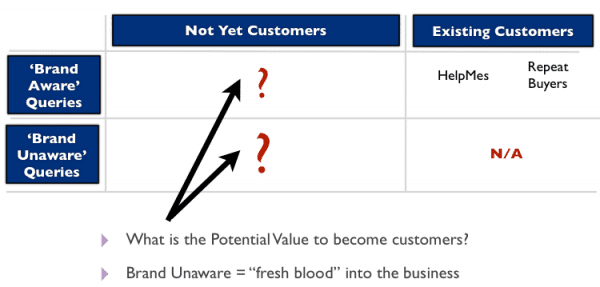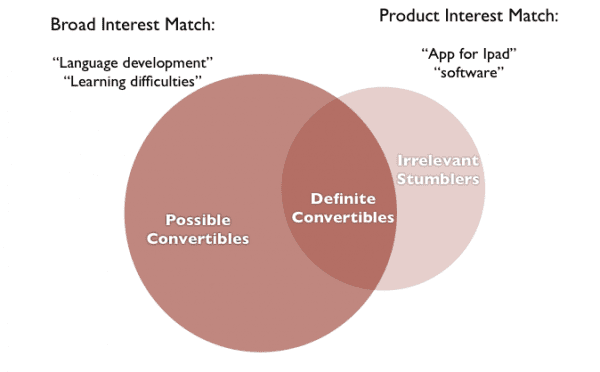A step-by-step approach to identify and attract visitors with higher intent to purchase
In part 1, Why your conversion rate is lying to you, I explained why using average conversion rate to measure the performance of search campaigns paints a misleading picture of search success (or failure). Search traffic (both organic and paid) has a mixed potential for convertibility which dictates that you can reasonably expect visitors with different likelihood to convert to exhibit different behaviour.
While that theory has legs (please leave your thoughts in the comments if you agree and especially if you disagree), Part 1 did not answer the question:
How do you actually use people-focused analytics to identify visitors by potential for conversion?
So let's explore this further.
Intent dictates the reason for visit
Visitor intent dictates reason for visit and as a byproduct, the potential for conversion. If the visitor is there for a completely different reason (like a customer seeking support, Journalist seeking press pack or even customer seeking branch locator), then they are highly unlikely to convert and it would be an unreasonable expectation for them to do so.
So the first piece of the puzzle is to determine the reason why search visitors are there on that visit (remember that over the course of a visitor’s relationship with you they may visit many times and the reason behind their visit is likely to change as their relationship with you changes).
Identify User Intent using the meaning of Keyphrases
Search offers hands-down the best way to determine visitor intent at large scale by analysing the semantical meaning of keyphrases people use. This is not a new concept. Google has gradually been putting semantic search at the core of its search algorithm with the aim to return search results that best match the visitor’s intent ,(rather than the literal meaning of the query), and incorporating machine-learning is just the next step.
Good SEOs have focused on user intent (and therefore on people, not keywords), for years, using a number of models.
SEO Models
I have personally found the latter to be more valuable (but more difficult to put into practice) because the Navigational, Informational and Transactional model, on its own, doesn’t indicate neither the potential nor the proximity to conversion in the Navigational and Informational categories (where the bulk of keywords usually fall into).
Here are two approaches that can be used to understand the value of visitors from SEO:
Approach #1: Segment Keywords by Intent
The most common advice (and examples) on how to do semantic search classification is to choose a keyphrase and based on specific trigger words contained within, determine the underlying intent.

This advice, while sound and logical has one major flaw (which I have discovered the hard way):
- It does not provide a way to deal with keywords that inevitably fall into more than one category (beyond suggesting to use your judgement to assign the most appropriate intent classification. This is simply not feasible when you have thousands and thousands of rows of data).
- Even if you did assign multiple possible classifications to a keyword, you would simply end up with a bunch of keyword segments. Without a logical relationship between these segments to help analyse people’s behaviour, all this method does is show that you are attracting a mix of intentions. On its own that is simply not actionable.
You can only identify the Convertibles (both high and low value ones) if you find a way to apply intent classification to large sets of data in a way that is practical. Here is my proposed technique.
Approach #2: People-Focused Keyword Analysis
Instead of starting with keyword classification, I suggest that you start with people classification, by customer lifecycle stage.
You then identify the kinds of keyphrases you would reasonably expect people to use based on stage and intent. Here’s how to do it:
- STEP 1. Identify Lifecycle Events which mark crucial behaviour shifts

Why Becomes Brand Aware and Becomes Customer? These events:
- Translate across industries and businesses.
- Mark very different interactions with the website, familiarity, different reasons for visiting, etc.
- And more importantly, translate into data: recency, frequency, engagement, conversion rates will be different depending on stage.
- STEP 2. Create the Brand Awareness and Customer Relationship matrix

- Keyword segmentation by brand is easy, therefore forms a great starting point.
- More importantly, brand awareness will impact the type of keyphrases likely to be searched for and likely visitor personas (e.g. an existing customer is far more �likely to use a branded query than an unbranded one).
- Not Yet Customer” segmentis of most interest:
- It has the widest mix of intentions and converting potential, so largely a mystery.
- Forms a sizeable chunk of traffic for most websites.
- Brand Unaware segment is of particular interest as most customers start here (at some point) and represents “fresh blood” for the business.
- STEP 3. Determine Convertibility based on what Keywords are likely to be searched for at every stage
My theory is that the potential for convertibility is determined by:
- Interest Match: Are visitors interested in what the website has to offer?
- Interest Strength: How interested are visitors in what the website has to offer?
How to Determine Interest Match
For someone to be Convertible they would have to be at least an Interest Match for the business. If their interest doesn’t match what the business has to offer then the potential is low or zero.
- Brand Unaware queries that include words which indicate visitors are interested in the broad topic, the problem or industry the business operates in. Think of it as the starting point for identifying your target audience in the broadest terms.
- All Brand Aware queries. If they search for your brand then they must have at least some interest.
Everyone else will likely have no or low potential to convert.The Inconvertibles (I like to call them the Irrelevant Stumblers). Their interest simply does not match what the business has to offer, even in the broadest sense.
Determine Interest Strength
Interest Match only helps determine whether the visitors are Convertible, it does not tell you how likely they are to be converted. This is where Interest Strength comes into play.
If Interest Match determines whether people are interested in what the website has to offer in the broadest terms, then Interest Strength looks to determine whether people also have a commercial interest in the type of product or service offered by the business:

- Brand Unaware queries that include both Broad Interest and Product Interest Match words (e.g. 'communication difficulty app')
- Brand Aware queries that indicate commercial interest in the company’s own product — rather than support (e.g. “[brand name] app pricing”)
- Step 4. Apply Convertibility Personas to Web Analytics Data
The technical aspects involved in this step is outside the scope of this blog post. However, the workflow involves creating custom dimensions which can be achieved in a number of ways with a variety of tools.
Custom dimensions are an additional layer of information which you apply to keywords. In the simplest terms, it’s a label you assign programatically (not manually) to keywords in your web analytics data.
The basic idea is that based on the definitions of convertibility you’ve established in the previous steps, you then create custom rules to apply these labels to large sets of data.

This achieves the first step, assigning keyword classification labels based on ‘trigger’ words contained within. Armed with these labels and having already established how these labels relate to each other you then create conditional custom dimensions:

You then aggregate the data using pivot tables:

Notice how the differences between people’s intentions are leaping off the spreadsheet without having individual keywords clutter your vision. It instantly communicates the distribution of intentions and the behaviour of each segment.
Bottom Line, Put People Analysis at the heart of your Search Campaigns
I urge you to step away from the keyword list and focus on the searchers! To summarise:
- Identify visitor profiles based on what you reasonably expect their search behaviour to be at every stage in the customer lifecycle.
- Use these definitions to identify the mix of intentions search brings to your website.
- Accept that differences in potential for conversion (as well as proximity to conversion) dictates that you should reasonably expect different behaviour; macro and micro conversion rates, different response to different messaging, engagement rates, etc.
People-focused keyword analysis will change the way you evaluate search performance forever. It stops you obsessing about numbers and forces you to obsess about people.
If you’d like to know more, please get in touch at carmen at mardiros.net or leave a comment. This approach is very much a work in progress and I would love to hear how you address different intentions when you assess the performance of search.

Thanks to
Carmen Mardiros for sharing her advice and opinions in this post. Carmen Mardiros is an entrepreneur and independent web analytics consultant with a mission to help tech companies use data to reduce friction in their conversion funnel. You can follow her on
Twitter or connect on
LinkedIn.








 Thanks to
Thanks to 


